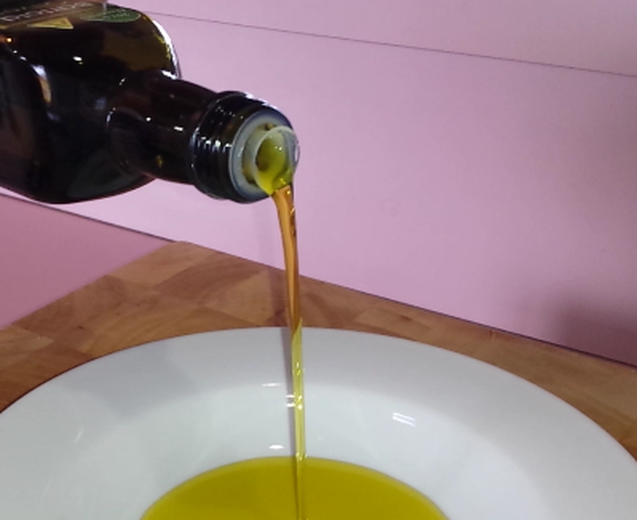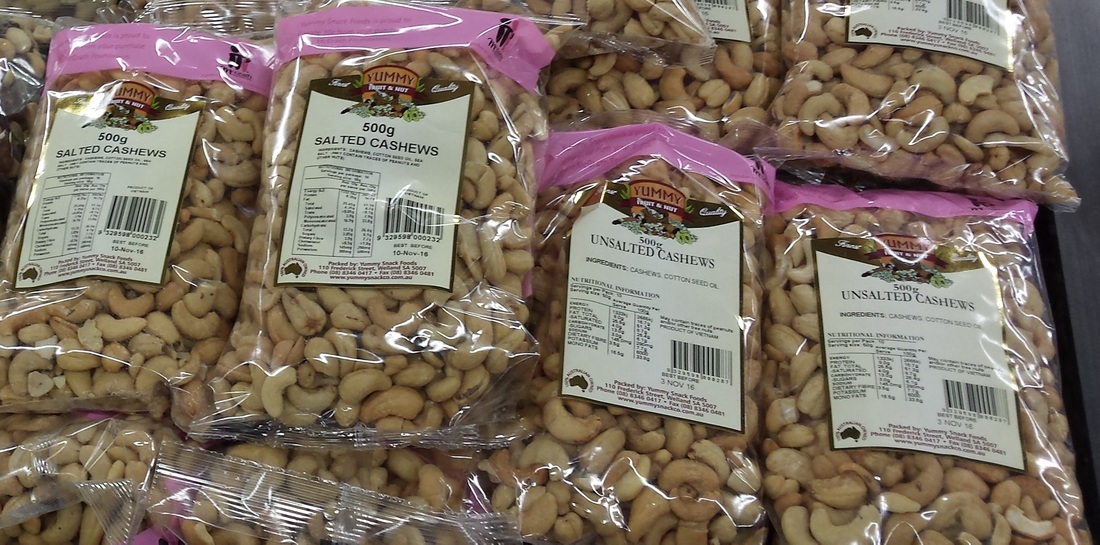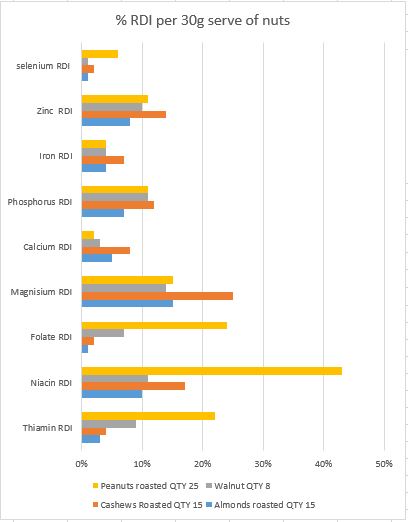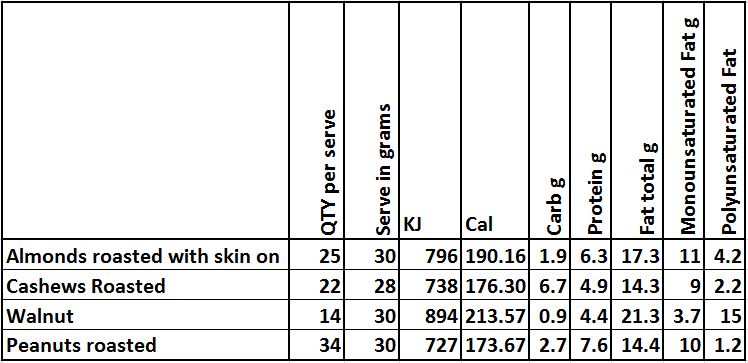|
Question: Why are some fats considered good and some bad?
Answer: This post is a follow up to my previous blog post “How do nuts fit into a healthy diet?” In my last blog post I mentioned that nuts contain monounsaturated oils and the polyunsaturated omega 6 and omega 3 oils. These oils have been shown to have real health benefits. I won’t go into the chemistry behind what makes these oils unsaturated, but will say that the shape of these fatty acids makes them liquid at room temperature. Unsaturated fats are an important part of a healthy diet. Saturated fats on the other hand, should be kept to a minimum. There is a lot of evidence linking them to heart disease. The shape of saturated fatty acids allows them to stack more tightly together which is why they are solid at room temperature. Saturated fats have been linked to high cholesterol. This is because saturated fats raise Low Density Lipoproteins (LDL) levels in our blood. LDL is a transporter of fats, in this case that happens to be cholesterol. The problem with LDL is that it’s not only a transporter of cholesterol, it also deposits cholesterol. In the right amount this is a good thing! Most of the cholesterol in our body is produced in our liver, it has many important uses. We use it to produce hormones and bile acid and it is the structural component of cell membranes, so we definitely need cholesterol. However, if your LDL levels are too high you’ll start to get cholesterol deposited in places that you don’t want it, the coronary arteries!! That’s a good enough reason to limit the amount of saturated fats in your diet. The foods that contain saturated fats are predominantly animal products. Having said that, it’s also found in some plant based foods such as coconut and palm products. As usual with the food and diet industry there is always some new trend around. Coconut oil seems to be the latest trend. Just be aware that coconut oil is actually more saturated than the fat found in animal products and like all other fat is high in kilojoules, so it’s not necessarily the healthiest choice. Having said that, you don’t need to exclude it from your diet, you just need to be aware of what it is and use it sparingly. Trans fats are another type of fat that you should try to minimise in your diet. They raise LDL in the same way that saturated fats do. In high intakes they lower HDL as well. Trans-fats also appear to increase inflammation and promote insulin resistance. Trans fats occur naturally in small amounts in some foods, but are generally produced by some sort of food processing. The process of making polyunsaturated oils into margarine produces trans fats although the technology used in Australia limit the amount produced. Some manufacturers now offer non hydrogenated trans-fat free margarines. Now let’s get to the healthy fats! Monounsaturated oils tend to have the opposite effect on cholesterol compared to saturated fats. They have been shown to raise the level of High Density Lipoprotein (HDL) in your blood. HDL is also a transporter of cholesterol, but unlike LDL it doesn’t deposit cholesterol in your arteries. HDL picks up cholesterol from around your body and transports it back to the liver to be recycled or excreted. This is the reason it’s important to have the correct ratio of LDL to HDL in your blood. They both have really important jobs to do and when they work together in the right amounts, they keep things working how they should. The polyunsaturated fatty acids Linoleic Acid and Linolenic Acid need to be supplied in our diet. They are essential fatty acids. They are essential because our body doesn’t have the ability to produce sufficient amounts to meet our physiological needs. We can however produce the longer chained polyunsaturated oils EPA, DHA and arachidonic from these essential oils. The long chained omega 3 polyunsaturated fatty acids EPA and DHA are needed for normal growth and development, especially for the brain and eyes. EPA and DHA can also be obtained directly from certain foods. Good sources of these long chained polyunsaturated fatty acids are fatty fish like salmon, tuna, mackerel, sardines and herring. The omega 6 oils are found in vegetables and seeds. They have been shown to have an effect on lowering both LDL and HDL. The omega oils also play a role in controlling the inflammatory response in our body. You’re probably thinking great! Now I not only have to worry about how much fat I have in my diet, I have to make sure I’m getting the right amount of the good fats and limiting the amount of bad fats!! The diet and weight loss industry has done a really good job of confusing and over complicating what a healthy diet looks like! It’s pretty simple really, eat a variety of fresh produce, don’t over eat and keep highly processed and packaged foods to a minimum. That’s basically the Australian Dietary Guidelines and if you eat in line with these guidelines you’ll be ticking all the right boxes as far as healthy fats and not so healthy fats go. If you found this story interesting or useful, please share it with your friends on facebook and encourage them to like follow us. If they aren’t on facebook all our blog stories are available from our website www.astutefitness.com.au Thanks Daryl
0 Comments
Question: How do nuts fit into a healthy diet? Answer: Nuts are a great food to include in a healthy diet. They are a great snack, and are packed full of nutrients. Nuts are an excellent source of mono unsaturated oils which are important for heart health. They are a good source of the essential polyunsaturated omega 3 and omega 6 oils. I don’t have enough space in this article to let you know all the benefits of these oils to your health, so will save that for another post. Nuts also contain a range of important micronutrients. The thing to keep in mind though, is that you don’t need to eat many nut to add a lot of kilojoules to your daily intake, so serving size is very important. All fats contain 37kJ per gram (even the healthy ones) compared to carbohydrates at 16kJ per gram and protein at 17kJ per gram. That’s over twice the energy content of carbs and protein. Just like all the food groups, serving size important. In the Australian Dietary guidelines, nuts are part of the Lean meat, poultry, fish, eggs, tofu, seeds and legumes food group. The recommended serving size for nuts is 30g. You have to keep in mind that women only need 2 ½ serves and men only 3 serves from this group each day. Having to many nuts as a snack will mean you need to reduce the quantity of other foods in this group. This could mean that you would need to reduce the serves of lean meat, chicken, fish or other protein foods in your main meals. For this reason, I would suggest a ½ serve for snacks. Compared to other packaged snacks nuts are relatively un processed. In most cases the only processing is roasting. Try to stick to un salted! You’ve probably heard of the trend of eating activated almonds. This appears to be based more on opinions than science! But if you like the taste of activated almonds then why not. They still have all the same nutrients. Figure 1, gives you % RDI for some of the micronutrients found in a few of the more common nuts we snack on (including peanuts which are actually a legume). You can see that for a relatively small serve they can contribute a lot of nutrition to your day. Figure 1: Figure 2, shows why you have to make sure not to overdo it with nuts! For a small serve they contain a lot of energy. Figure 2: Even though nuts are a great food, for people with nut allergies they can be very dangerous. If you ever have some sort of reaction to nuts, or to any other foods for that matter, don’t self-diagnose, go and talk to your GP about it straight away!
The Australian Dietary Guidelines are a great resource for anyone who is interested in maintaining a healthy diet. The main message is to eat a variety of fresh produce in the right amounts and include at least 30 minutes of exercise each day. Do this and you’ll be giving yourself the best chance of having a long and healthy life. For most people nutrition is pretty simple really, don’t fall into the trap of following the latest fad! Keep it simple!! If you found this article interesting and useful, please tell your friends. Follow Astute Fitness on facebook or go to www.astitefitness.com.au to keep up with our latest stories. |
AuthorDaryl Maddern Archives
July 2019
Categories |





 RSS Feed
RSS Feed